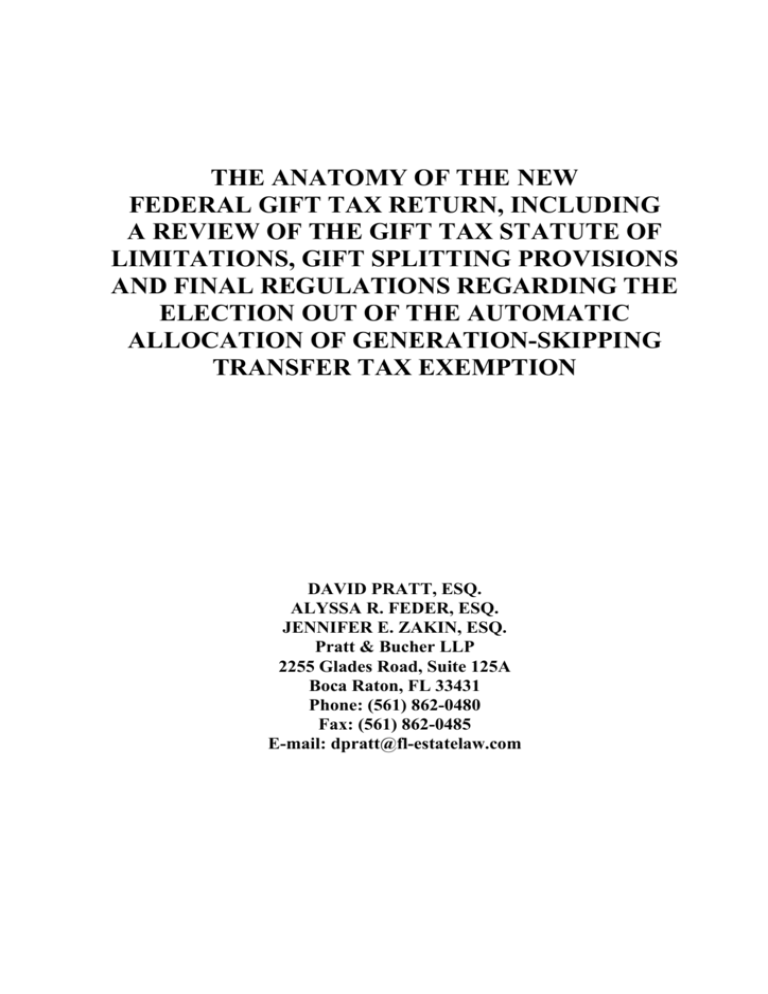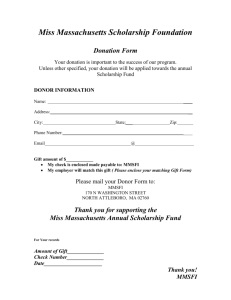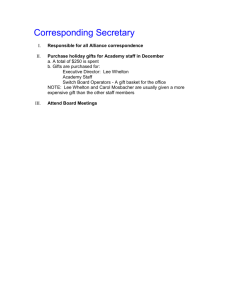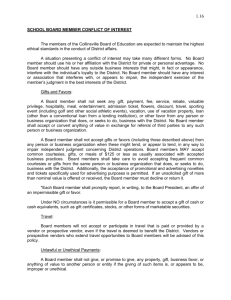
THE ANATOMY OF THE NEW
FEDERAL GIFT TAX RETURN, INCLUDING
A REVIEW OF THE GIFT TAX STATUTE OF
LIMITATIONS, GIFT SPLITTING PROVISIONS
AND FINAL REGULATIONS REGARDING THE
ELECTION OUT OF THE AUTOMATIC
ALLOCATION OF GENERATION-SKIPPING
TRANSFER TAX EXEMPTION
DAVID PRATT, ESQ.
ALYSSA R. FEDER, ESQ.
JENNIFER E. ZAKIN, ESQ.
Pratt & Bucher LLP
2255 Glades Road, Suite 125A
Boca Raton, FL 33431
Phone: (561) 862-0480
Fax: (561) 862-0485
E-mail: dpratt@fl-estatelaw.com
THE ANATOMY OF THE NEW FEDERAL GIFT TAX RETURN,
INCLUDING A REVIEW OF THE GIFT TAX STATUTE OF
LIMITATIONS, GIFT SPLITTING PROVISIONS AND FINAL
REGULATIONS REGARDING THE ELECTION OUT OF THE
AUTOMATIC ALLOCATION OF GENERATION-SKIPPING TRANSFER
TAX EXEMPTION
By: David Pratt, Esq., Alyssa R. Feder, Esq. and Jennifer E. Zakin, Esq.
© David Pratt, Esq., Alyssa R. Feder, Esq. and Jennifer E. Zakin, Esq. 2005 All rights reserved.
I.
INTRODUCTION.
In 2004, the Internal Revenue Service (the “IRS”) substantially revised Form 709, United
States (and Generation-Skipping Transfer Tax Return) (the “709"), which is applicable to gifts
made in 2003. In 2005, the IRS released another revised Form 709, which is substantially the
same as the 2003 709. A copy of the 2004 709 and corresponding instructions is attached as
Exhibit A. The most significant change to Form 709 (from the 2002 and prior year’s forms) was
to Schedule A. Specifically, a new Part 3 and three additional columns were added. Such
revisions were implemented to (1) modify the method in which spouses who elect to gift-split
report such gifts under Section 2513 of the Internal Revenue Code of 1986, as amended (the
“Code”); (2) add a section to Schedule A to report “indirect skips;” (3) add a mechanism to elect
out of the automatic allocation of generation-skipping transfer (“GST”) tax exemption for direct
and indirect skips; and (4) add a line to Part 2 of Schedule C (GST tax schedule) to illustrate the
automatic allocation of GST tax when an indirect skip is reported. Even though the 709 has
changed significantly from its prior version, practitioners who file returns to report gifts made
prior to 2003 will presumably still need to use the prior form for the applicable year.
II.
INITIAL CONSIDERATIONS.
A.
Reportable gifts. Any individual citizen or resident of the United States who
makes a transfer by gift must file a 709, unless such transfer is not includible in
such individual’s total amount of gifts for the year by the application of Sections
2503(b) or 2503(e) of the Code, or when such individual makes a transfer of an
interest with respect to which a marital deduction is allowed for the value of the
entire interest under Section 2523 of the Code. I.R.C. §6019(a). It is necessary to
file a 709 in order to elect to gift-split under Section 2513 of the Code, regardless
of the amount of the gift. Section VII. of this outline provides a detailed analysis
of the gift-splitting rules under Section 2513 of the Code.
1.
Section 2503(b).
Section 2503(b) provides that in the case of present interest gifts made by
a donor during the year, the first $10,000 of each gift (indexed for
inflation and currently $11,000) shall not be included in the total amount
of gifts made during the year by the donor. Section 2523(i) of the Code
1
substitutes $100,000 (indexed for inflation and currently $117,000) for the
$10,000 figure provided in Section 2503(b) of the Code when the donee
spouse is a non-US Citizen.
2.
Section 2503(e).
3.
Section 2503(e) provides that a “qualified transfer” shall not be treated as
a transfer of property for gift tax purposes. A qualified transfer is a
transfer of tuition for the benefit of the donee paid directly to the
educational institution, or the payment of medical care for the benefit of
the donee paid directly to the medical care provider.
Section 2523.
a.
General. Section 2523 provides that when a donor transfers an
interest in property to an individual, who at the time of the gift is
the donor’s spouse, a deduction shall be allowed in computing the
donor’s taxable gifts for the year in an amount equal to the value of
the property transferred.
b.
Inter Vivos Qualified Terminable Interest Property (“QTIP”)
Trusts. If the donor transfers property to a QTIP trust for the
benefit of his or her spouse, and wants to make a QTIP election
with respect to such transfer, a 709 must be filed in order to make
the election. Such an election can only be made on a timely filed
709 (including extensions). Treas. Reg. §25.2523(f)-1(b)(4)(i). If
the donor dies during the same year of the transfer, the election
must be made on a 709 filed no later than the due date of the
Federal estate tax return (including extensions). Treas. Reg.
§25.2523(f)-1(b)(4)(ii).
Because this election is prescribed by statute, as opposed to being
a regulatory election, Section 9100 relief is unavailable to make a
late QTIP election under Section 2523 of the Code. PLR 9641023
(July 10, 1996).
B.
Form 709-A. Form 709-A, which previously could be used by taxpayers solely
to report split gifts in limited circumstances, is now obsolete. All reportable gifts
must now be reported on Form 709.
C.
Party responsible for filing the 709.
1.
General. The donor is required to file the 709. I.R.C. §6019(a).
2.
Donor is unable to sign. If a donor is legally incompetent, his guardian
may file a 709 on his behalf. Treas. Reg. §25.6019-1(g). Additionally,
an agent of the donor may file the 709 on behalf of the donor. In order for
2
an agent to file on behalf of a donor, the donor must be unable to file for
himself by reason of illness, absence, or nonresidence, and such return
must be ratified by the donor when he becomes able to do so. An agent
may not sign on behalf of the donor as a matter of mere convenience.
Treas. Reg. § 25.6019-1(h); Revenue Ruling 78-27, 1978-1 C.B. 387.
3.
D.
Donor is deceased. If the donor is deceased, the executor of the deceased
donor’s estate may file the 709 on behalf of the donor for gifts made prior
to the donor’s death.
Treas. Reg. §25.6019-1(g). In addition, the
executor may elect to gift-split under Section 2513 of the Code on behalf
of the donor.
Due date.
1.
2.
General. The 709 may not be filed prior to January 1st of the year
following the year in which the gift was made, and cannot be filed later
than April 15th of such year, unless the appropriate extension of time to
file is requested. I.R.C. §6075(b).
Extensions. If the taxpayer files Form 4868 to automatically extend the
due date of his or her individual income tax return by four months to
August 15th, such extension will also automatically extend the time to file
his or her 709. I.R.C. §6075(b)(2). It is no longer necessary for the
taxpayer to check a box in order to extend the due date of his or her 709.
A copy of Form 4868 is attached as Exhibit B. In addition, if the taxpayer
files Form 2688 to request an additional extension of time to file his or her
individual income tax return to October 15th, such extension will also
extend the time to file his or her 709. A copy of Form 2688 is attached as
Exhibit C. It is important to note that a taxpayer may no longer submit
payment of gift or GST tax with Form 4688 or Form 2688.
If the taxpayer is not requesting an extension of time to file his or her
individual income tax return or the taxpayer owes gift or GST tax, the
taxpayer must file Form 8892 by April 15th. This filing of Form 8892 will
extend the due date for the 709 until October 15th. A copy of Form 8892 is
attached hereto as Exhibit D.
E.
Where to file.
1.
Within the U.S. Individuals located within the United States or the
District of Columbia should file their 709s in Cincinnati, Ohio at the
following address:
INTERNAL REVENUE SERVICE
CINCINNATI, OHIO 45999
3
2
Outside of the U.S. Individuals located elsewhere or have an APO or FPO
address should file their 709s in Philadelphia, Pennsylvania at the
following address:
INTERNAL REVENUE SERVICE
PHILADELPHIA, PENNSYLVANIA 19255
F.
III.
Method of Payment. Payment of any gift (or GST) tax due can be made by
personal check or money order payable to the United Stated Department of
Treasury. The instrument should also bear the donor’s social security number.
THE ANATOMY OF THE RETURN.
This section of the outline will describe the method of reporting gifts and the allocation
of GST tax exemption on a 2002 (and prior years) 709, followed by a detailed description of how
the reporting should be done on the new 709.
A.
Page 1.
1.
Part 1 (709 prior to 2003).
Part 1 is the General Information section in which the taxpayer provides
the IRS with basic information, such as his or her name, social security
number and address. In addition, the taxpayer answers various questions.
For example, the taxpayer will address whether the 709 was put on
extension and whether he or she has previously filed a 709. Part 1 also
provides an area in which the taxpayer can elect to have the gifts made by
him or her to third parties considered as gifted one-half (½) by the
taxpayer and one-half (½) by the taxpayer’s spouse. If the taxpayer elects
to gift-split, his or her spouse is required to provide his or her social
security number, where indicated, on Part 1 of the 709 and sign, where
indicated, on line 18. The consenting spouse must also file his or her own
709 in order to report one-half (½) of the gifts made by his or her spouse,
unless only one spouse made a gift during the year and the value of such
gift was less than two times the annual exclusion amount.
2.
Part 2 (709 prior to 2003).
Part 2 of the 709 is the Tax Computation section, wherein the amount of
taxable gifts is carried over from Schedule A and the tax due, taking into
account the taxpayer’s available gift tax exemption, is calculated.
3.
New 709.
Page 1 of the 709 was not substantially altered. The only change made
was to line 1 of Part 2 so that the value carried over from Schedule A is
4
taken from line 11 of Part 4, rather than from line 15 of Part 3, as it was on
the 2002 709. The reason for such change is described in Section III. B.
of this outline, wherein the changes to Schedule A are discussed.
It should also be noted that the spousal consent for gift-splitting under
Section 2513 of the Code contained in Part 1 of the 709 has remained
unchanged, although the method to report split gifts has changed
significantly, as described in Section III. B. of this outline, wherein the
changes on how split gifts are reported on Schedule A are discussed.
B.
Schedule A.
On the 2002 709 and prior year’s forms, Schedule A consists of Part 1 - Gifts
Subject Only to Gift Tax, Part 2 - Gifts that are Direct Skips and Subject to Both Gift Tax
and Generation-Skipping Transfer Tax and Part 3 - Taxable Gift Reconciliation. The
new 709 adds a new Part 3 and moves the tax reconciliation section to Part 4. In
addition, a new column C was added, which is used in Part 2 and Part 3 to elect out of the
automatic allocation of GST tax exemption, as discussed in greater detail below. The
method of reporting split gifts was also significantly changed by the addition of columns
G and H.
1.
Questions A and B (709 prior to 2003).
a.
Valuation discounts. The taxpayer must indicate in question A,
located at the top of Schedule A, whether the value of any gift
reported on Schedule A reflects a discount of any kind, including,
but not limited to, lack of marketability, fractional interest or
minority interest discounts. If so, the taxpayer must attach an
explanation giving the basis for taking such discounts. For
example, if a taxpayer gifted limited partnership units and the
value of such units reflects discounts for lack of marketability and
minority interest, question A must be answered yes and an
appraisal of the limited partnership units must be attached to the
709. See sample 709 #3 (Exhibit G-3) for an example of reporting
a gift of discounted limited partnership units on a new 709.
i.
b.
Section 6501 of the Code. It should be noted that the
proper disclosures should be made when reporting a gift,
the value of which was discounted, in order to commence
the gift tax statute of limitations. Section VI. of this outline
discusses the adequate disclosure requirements of Section
6501 of the Code in detail.
Qualified state tuition programs. If a taxpayer gifted cash to a
qualified state tuition plan under Section 529 of the Code in excess
of the annual exclusion amount ($11,000 in 2005) on behalf of any
5







